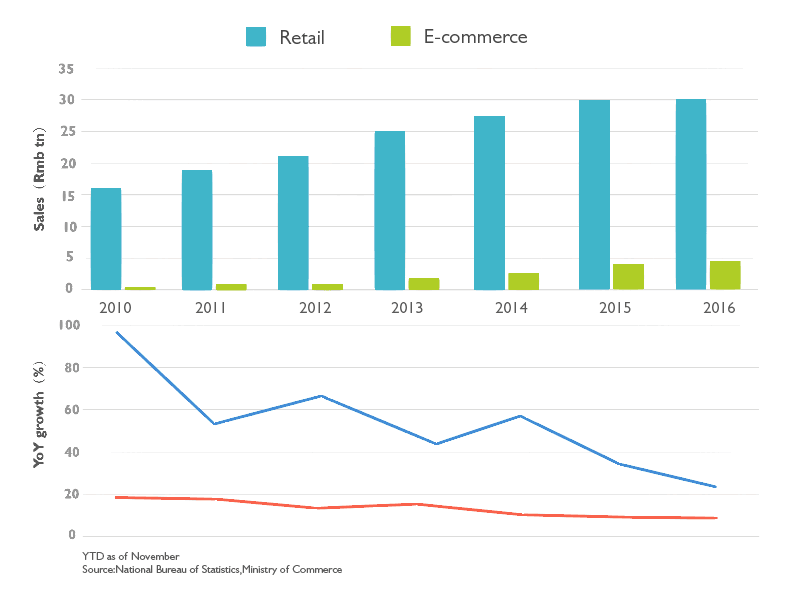Omni-Channel 2017: Physical Retail Back in the Race
Retailers will not simply launch their online stores with their brick and mortar stores and call it omni-channel, because that will not be enough for them anymore.
by Azoya

Omni-Channel is a keyword of 2017 trends, but it is not an entirely new concept for retailers.
Back in the 90s, top retailers have already incorporated digital retail in their portfolio of sales channels. Big data processing is nothing new, nor is converting offline traffic to online buyers or backward. Major global retailer had already employed information processing technology to expand business channels and enhance customer experience some twenty years ago.
Omni-channel in China, however, is going through a different process. Here are the 3 reasons that makes 2017 a very important year for omni-channel in China.
Reason 1: Changing of consumer behavior and the consumer-centric approach
Consumer behavior has changed dramatically these few years with fast growth in the E-commerce sectors, emerging of social media and mobile payment. Chinese consumers can now acquire products from more than just one source. With a simple click on the E-commerce websites, consumers can sit back at home to wait for deliveries in 2 to 3 days. New technologies, improved logistics have reduced the gap of shopping experience between online and offline, and retailers are also renovating their thinking to become more customer-centric instead of blindly expanding their sales channels.
In the era of omni-channel, tech-savvy retailers are more than ever engaged with social media and new digital channels to provide better customer services, which include navigation, customer education, information updates, customer loyalty programs, logistics, etc. One of the heated discussions during the International Council of Shopping Center (ICSC) 2016 forum also suggested that channels should be used to cater for customer needs and retailers shouldn’t expand channels for the sake of expanding.
Retailers will not simply launch their E-commerce sites along with their brick and mortar stores and call it omni-channel, because that will not be enough for them anymore. It also requires that retailers can provide consistence prices, customer services across all channels, and enhance their logistics capability.
Reason 2: Online market is becoming more competitive
The E-commerce sector has been growing very fast in the past few years, but please also note that the speed of growth is slowing down recent years. Figures from National Bureau of Statistics has shown that YoY growth of E-commerce sales went down from nearly 90% of growth in 2010, to 22.3% in first three quarters of 2016.

Increased traffic acquisition cost is one of the reasons that made E-commerce a difficult option for retailers. Number of retailers that opened virtual stores online soared the last couple of year, but online shoppers was increasing at a lower rate around 6% to 10% according to CNNIC 2016 report, resulting in rise of traffic acquisition cost.
The increased costs of managing E-commerce business has made both online retailers to look for new opportunities through physical retail, while on the other hand, physical retail are continuing to expand their operations to online channels either to generate more sales or to introduce more offline traffic. This creates a synergy for both online and physical retailers and the solution is the omni-channel retailing.
Reason 3: Mobile payment penetration is at an all-time high
Penetration of mobile payment is very high in China. With 6 out of 10 people using mobile apps to pay for the merchandises, it has created many opportunities for retailers. Some popular mobile payment methods such as WeChat Pay are integrated with the social function, which allows customers to follow the official accounts and engage with the retailers. Retailers can know when and where customers have purchased anything and by analyzing these data, retailers can understand their purchase preferences and behavior to provide better customer service.
The emerging of mobile payment has greatly speed up the process of omni-channel in China. For retailers both online and offline, mobile payment provides a gateway for each side to drives traffic to the other. Combination of physical retail with mobile payment will be one of the key trends in 2017.
While for overseas retailers, integrating China mobile payment methods in their E-commerce website and offline cash terminal can be the opportunities to build their brand among increasing Chinese tourists and the burgeoning Chinese middle class. These affluent Chinese consumers are looking beyond high-quality products for tailored customer services such as fast and secure transaction, navigation, content and loyalty rewards.
FULLY MANAGED CROSS-BORDER E-COMMMERCE SOLUTIONS
| China E-commerce Cloud Services | International Brand Agency | Cross-border O2O |
9 SERVICE BUILDING BLOCKS
| Elastic Cloud | E-com Platform Setup | Marketing |
| Managed Operations | China Payment | International Logistics |
| Customer Service | Value-added Services | Omni-Channel Kits |